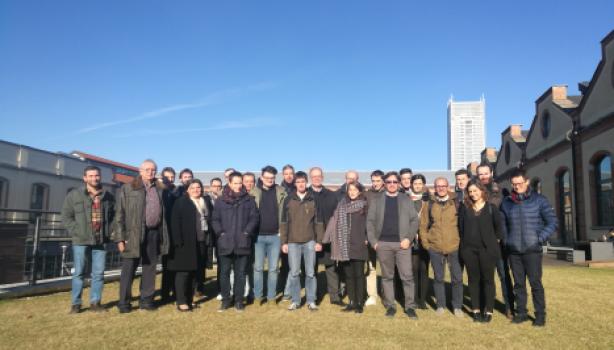Group photo from the 5th Energy for Sustainable Science at Research Infrastructures workshop. (Image: PSI)
On 28 and 29 November, CERN took part in the 5th Energy for Sustainable Science at Research Infrastructures workshop at the Paul Scherrer Institute – PSI, in Villigen, Switzerland.
The Energy for Sustainable Science at Research Infrastructures workshop series was established in 2011 by CERN, the European Spallation Source – ESS (Sweden), and the Association of European-Level Research Infrastructures Facilities – ERF. It brings delegates from research institutes together with policymakers from around the world to discuss energy sustainability.
The fifth edition was organised by PSI in collaboration with CERN, ERF, ESS and the H2020 project ARIES (Accelerator Research and Innovation for European Science and Society). The goals of this year’s workshop were to discuss energy management, efficiency, storage and savings, to pinpoint and share good practice and identify potential future technological solutions. In addition to that, the workshop stimulates new initiatives and cooperation amongst institutes.
Among the highlights was a presentation from Stefan Oberholzer, Head of Photovoltaics and Central Solar Power at the Swiss Federal Office of Energy – SFOE. He spoke about the Swiss Energy Strategy 2050, explaining that the strategy’s priorities are efficiency, increasing energy from renewable sources, security of supply, and strengthening energy research. Oberholzer also discussed the opportunities and challenges with energy storage and renewable sources, such as photovoltaics. Large storage systems were also the subject of a presentation from Michel Düren, a Professor at the Justus-Liebig-Universität Gießen. He concluded that the scientific community could play a leading role in demonstrating best practice for the energy transition that we are now facing.
Among the presentations from CERN was one from Laurent Tavian, High-Luminosity Project Office Coordinator, who presented a project for energy efficient refrigeration for the Future Circular Collider (FCC). Instead of conventional cryoplants, where helium is the refrigerant, the project found that a mix of helium and neon makes a more energy efficient cooling system. Over 10 years, this could save up to 3 TWh of energy.
Amalia Ballarino, CERN’s Head of Superconducting Devices, presented a project on magnesium diboride (MgB2) based power transmission lines for powering the High-Luminosity LHC superconducting magnets. Magnesium diboride is superconducting at 39K, the highest temperature among conventional superconductors, making it interesting from an energy efficiency perspective both for accelerator applications and for potential electricity distribution systems in towns and cities.
Serge Deleval, Deputy Group Leader for cooling and ventilation at CERN, gave a talk on water consumption and its environmental impacts, a first for this workshop series. He presented recent studies on minimising the increase of water consumption and reducing the environmental impact of cooling tower effluents.
In summing up the workshop, Frédérick Bordry, CERN’s Director for Accelerators and Technology, concluded very succinctly that: “Research infrastructures don’t want to represent an energy issue for society. We wish to contribute to good practices and find solutions for the future”.
The next workshop on Energy for Sustainable Science will be held in 2021 in Grenoble, France.
All the presentations from this year’s workshop can be found here.
News item also published in the CERN Bulletin.





